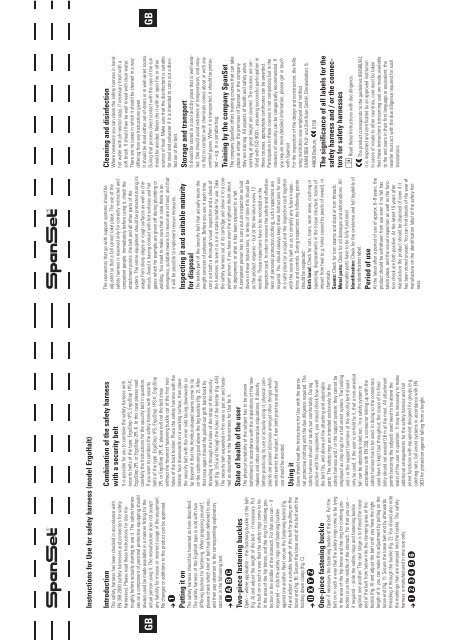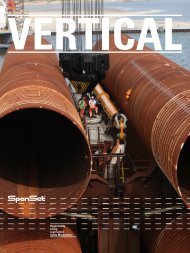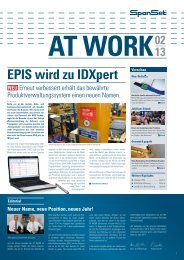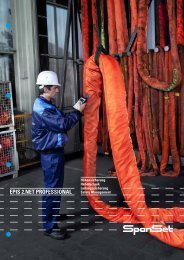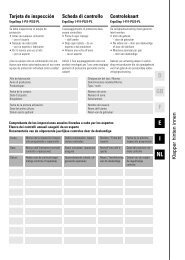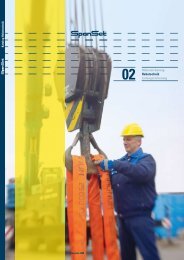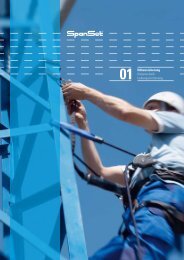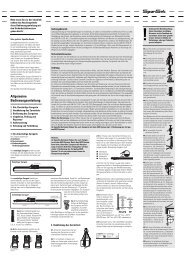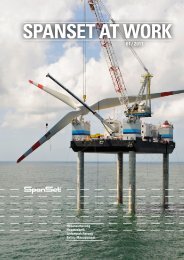-GA ErgoHalt ohn Steigschutzı - SpanSet GmbH & Co. KG
-GA ErgoHalt ohn Steigschutzı - SpanSet GmbH & Co. KG
-GA ErgoHalt ohn Steigschutzı - SpanSet GmbH & Co. KG
You also want an ePaper? Increase the reach of your titles
YUMPU automatically turns print PDFs into web optimized ePapers that Google loves.
Instructions for Use for safety harness (model <strong>ErgoHalt</strong>)<br />
D<br />
Cleaning and disinfection<br />
Where necessary you can clean the safety harness in handhot<br />
water with ph-neutral soap, if necessary treat with a<br />
soft brush. It should then be well rinsed with clear water.<br />
There are no cases in which it should be cleaned in a way<br />
differing from any Instructions given.<br />
It should be dried either out-of-doors or in well-aired rooms.<br />
During that process direct contact with the rays of the sun<br />
should be avoided. Never dry it with an open fire or other<br />
sources of heat. Make sure that the disinfectant is suitable<br />
for steel and polyester if it is intended to carry out a disinfection<br />
of the belt.<br />
Storage and transport<br />
It should be stored in a cool and dry place that is well-aerated.<br />
One should avoid extremes of temperatures, and ensure<br />
that no contact with chemicals comes about or with any<br />
emitted gases. When it is transported, it should be protected<br />
– e.g. in a suitable bag.<br />
Training by the company <strong>SpanSet</strong><br />
The company <strong>SpanSet</strong> offers training courses that can take<br />
place at either the premises of Spanset or the company<br />
they are training. All aspects of health and safety when<br />
working at great height are covered. The courses are certified<br />
with ISO-9001-; assuming successful participation in<br />
these courses, appropriate certificates can be awarded.<br />
Participation in these courses is not compulsory but in the<br />
interests of security can be categorically recommended. If<br />
you require more detailed information, please get in touch<br />
with Spanset<br />
For the inspection of the design and construction, the following<br />
institution was employed and notified<br />
EXAM BBG Prüf- und Zertifizier <strong>GmbH</strong>, Dinnendahlstr. 9,<br />
44809 Bochum, 0158<br />
The significance of all labels for the<br />
safety harness and / or the connectors<br />
for safety harnesses<br />
The connectors that go with support systems should be<br />
adjusted so that a fall cannot take place. The use of the<br />
safety harness is reserved only for correctly instructed and<br />
competent people. Immediately before using it, check the<br />
attachment points, the belt and all other parts of the<br />
system. The entire equipment should be protected during its<br />
usage from sharp edges or rough surfaces as well as chemicals.<br />
Avoid it having contact with hot surfaces and hot<br />
gases which for example are given off during plumbing or<br />
welding. You need to make sure that in case there is an<br />
emergency, suitable means for rescue are at hand, and that<br />
it will be possible to implement rescue measures.<br />
Inspecting it and suitable maturity<br />
for disposal<br />
The textile part of the security belt that actually bears the<br />
weight consists of polyester. Before you use it each time,<br />
carry out both a thorough visual inspection and a check of<br />
the functions to see it is a in a state suitable for use. Take<br />
the safety harness out of its cartridge and show it to a competent<br />
person, if you have even the slightest doubt about<br />
its deployment; or after it has been exposed to a fall.<br />
A competent person has to carry out an inspection as laid<br />
down in these Instructions; in terms of time this should be<br />
as the product requires – but at the minimum every 12<br />
months. These inspections have to be recorded on the<br />
inspection card. In order to ensure the safety and effectiveness<br />
of personal protection clothing, such inspections are<br />
required. You should always keep these Instructions for use<br />
in a safe place (or a copy) and the inspection card together<br />
with the security belt so as to simplify any future inspections<br />
and controls. During inspections the following points<br />
should be respected:<br />
Girth band: Check for cuts, tears, worn areas, crushing or<br />
squeezing, displacements in the tissue structure, traces of<br />
impact from heat (e.g. holes caused by pearls of sweat), or<br />
chemicals.<br />
Seams: Check for torn seams and slack or torn threads.<br />
Metal parts: Check for all damages and deformations. All<br />
moveable parts have to be fully functional.<br />
Identification: Check for the existence and full legibility of<br />
the identification label.<br />
Period of use<br />
At the latest after a period of use of approx. 6–8 years, the<br />
product should be withdrawn from use even if no fall has<br />
taken place, and the visual inspection as well as the function<br />
check are both positive. At the latest 10 years after<br />
manufacture the product should be disposed of even if it<br />
has been stored unused. You can find details of the year of<br />
manufacture on the identification label of the safety harness.<br />
<strong>Co</strong>mbination of the safety harness<br />
with a security belt<br />
It is possible for you to combine the safety harness with<br />
security belts of the type: ErgoStop 1PS, ErgoStop 1PS-K,<br />
ErgoStop 2PL or ErgoStop 2PL-K. In this case please read<br />
carefully the Instructions for the security belt in question.<br />
If you want to combine the safety harness with security<br />
belts of the type: ErgoStop 1PS, ErgoStop 1PS-K, ErgoStop<br />
2PL or ErgoStop 2PL-K, please pull out the belt strap<br />
without the foremost fastening buckle out of the first two<br />
holes of the back bolster. Place the safety harness with the<br />
bolster face downwards on a working surface, then place<br />
the security belt with the inner side facing downwards so<br />
far beyond it that the rhombus-shaped seams come to lie<br />
on the cushioning pad above the leg buckles (fig. 2). After<br />
that once again thread the pulled-out girth band back by<br />
threading it through the holes of the strap of the security<br />
belt (fig. 3/5) and through the holes of the bolster (fig. 4/6).<br />
The security belt expanded in this way is put on and fastened<br />
as described in the Instructions for Use for it.<br />
State of health of the user<br />
The physical suitability of the subject has to be proven<br />
beforehand in accordance with the stipulations of the lawmakers<br />
and other administrative stipulations. If directly<br />
before practicing its use or actually using it, physical complaints<br />
are present (dizziness amongst other things) which<br />
would restrict the subject, then both practice and actual<br />
use should be avoided.<br />
Using it<br />
Users should read the Instructions for Use with the personal<br />
protective clothing with the due diligence required. The<br />
safety harness should sit tautly but comfortably. During<br />
practice with this equipment, you should check how well<br />
the belt fits, and above all the attaching and adjustable<br />
parts. The safety rings are intended exclusively for the<br />
safety harness and / or the support system; they cannot be<br />
employed as stop rings for a fall arrest system. The holding<br />
and / or the support functions of the security belt should<br />
only be used, if the user is so held by it, that a non-arrested<br />
fall can be absolutely ruled out. In a safety system in<br />
accordance with EN 358, a connector linking up with the<br />
safety harness has to be used. In doing so the connectors<br />
used have to kept taut throughout; the scope of its flexibility<br />
should not exceed 0.6 m at the most. All attachment<br />
points (securing the subject) used need to be above the<br />
waist of the user in question. It may be necessary to make<br />
additional arrangements for the safety harness and fall<br />
arrest functions with equipment designed for groups (e.g.<br />
catching nets, fall arrest systems in accordance with EN<br />
363) for protection against falling from a height.<br />
Introduction<br />
The safety harness has been checked in accordance with<br />
EN 358:2000 (safety harnesses and connectors for safety<br />
harnesses). Please read these Instructions for Use thoroughly<br />
before actually starting to use it. The safety harnesses<br />
as a component of personal protective equipping should<br />
always used be made available in a manner fitting for the<br />
actual person using it. The manufacturer does not accept<br />
any liability for misuse or incorrect usage of the equipment.<br />
No changes or additions to the product can be approved.<br />
D<br />
GB<br />
GB<br />
F<br />
<br />
Putting it on<br />
The safety harness should be fastened as here described.<br />
The safety harness of the Ergohalt type is sold with two<br />
differing buckles for fastening. When preparing yourself,<br />
please check which kind of belt has been delivered to you,<br />
and then pay attention to the corresponding explanatory<br />
section in the following text.<br />
F<br />
E<br />
E<br />
I<br />
I<br />
NL<br />
<br />
Two-piece fastening buckles<br />
Open – where applicable – the fastening buckle of the belt<br />
(fig. A) and adjust the length of the belt – if necessary. Put<br />
the belt on in such a way that the safety rings come to lie<br />
in the area of the hip bones, and the ring for climbing protection<br />
in the middle of the stomach. For that you can – if<br />
required – slide the safety rings and fastening buckles<br />
against one another. Next secure the fastening buckle (fig.<br />
A) and adjust a suitable length of the belt by pulling on the<br />
loose end (fig. B). Secure the loose end of the belt with the<br />
holding down clamp (fig. C).<br />
NL<br />
Read these Instructions with due diligence.<br />
The product corresponds to the guidelines 89/686/EU;<br />
it is inspected and certificated by an approved institution.<br />
In cases of resale to other countries, care must be taken<br />
that these Instructions (concerning use) are made available<br />
to the end users in their first language or equivalent; the<br />
reseller must act with the due diligence required for such<br />
translations.<br />
<br />
One-piece fastening buckle<br />
Open if necessary the fastening buckle of the belt. Put the<br />
belt on in such a way that the safety rings come to be lying<br />
in the area of the hip bones and the ring for climbing protection<br />
is on the middle of the stomach. For that you can –<br />
if required – slide the safety rings and fastening buckle<br />
against one another. The next stage is to thread the loose<br />
end of the belt from below into the clamping area of the<br />
buckle (fig. X) and adjust the belt until you have the right<br />
length of it; you can make this adjustment by pulling on the<br />
loose end (fig. Y). Secure the loose belt end by afterwards<br />
threading it through the buckle (fig. Z): You should also note<br />
the markings that are stamped into the buckle. The safety<br />
harness is manufactured in one size only.


